Top Customer Service Email Templates to Boost Satisfaction
Unlock the potential of your customer service with these 7 essential email templates. Learn how to craft welcome emails, order confirmations, problem resolutions, and more to boost engagement and satisfaction.
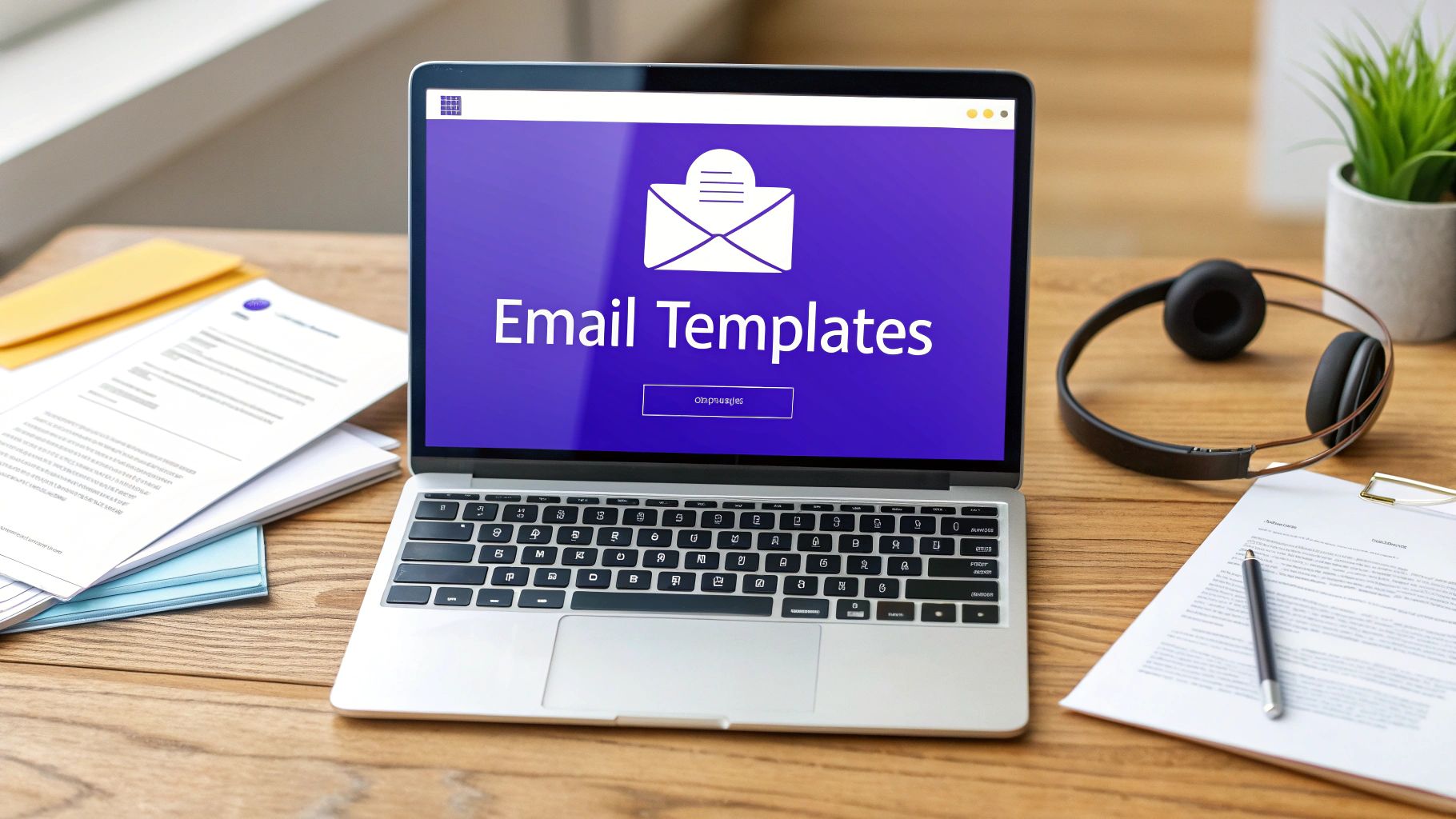
Transform Your Customer Service with Email Templates
Efficient communication is crucial for exceptional customer service. This article provides seven essential customer service email templates to streamline your workflow and improve customer satisfaction. Learn how to craft effective emails for various scenarios, from welcoming new customers and confirming orders to resolving problems and requesting feedback. Using these templates, plus tools like quiky.email for added personalization, empowers your team to handle every interaction professionally, ultimately boosting your business. These customer service email templates cover welcome emails, order confirmations, problem resolution, feedback requests, proactive service updates, thank you notes, and service renewals/upgrades.
1. Welcome Email Template
The welcome email is the digital handshake of your business, the first formal communication after a customer signs up for a service, makes a purchase, or subscribes to a newsletter. This crucial customer service email template sets the tone for your entire relationship with the customer, providing a first impression and outlining what they can expect moving forward. It bridges the gap between initial interest and ongoing engagement, serving as an onboarding tool and a foundation for future interactions. Effectively leveraging this template can significantly impact customer retention and overall satisfaction.
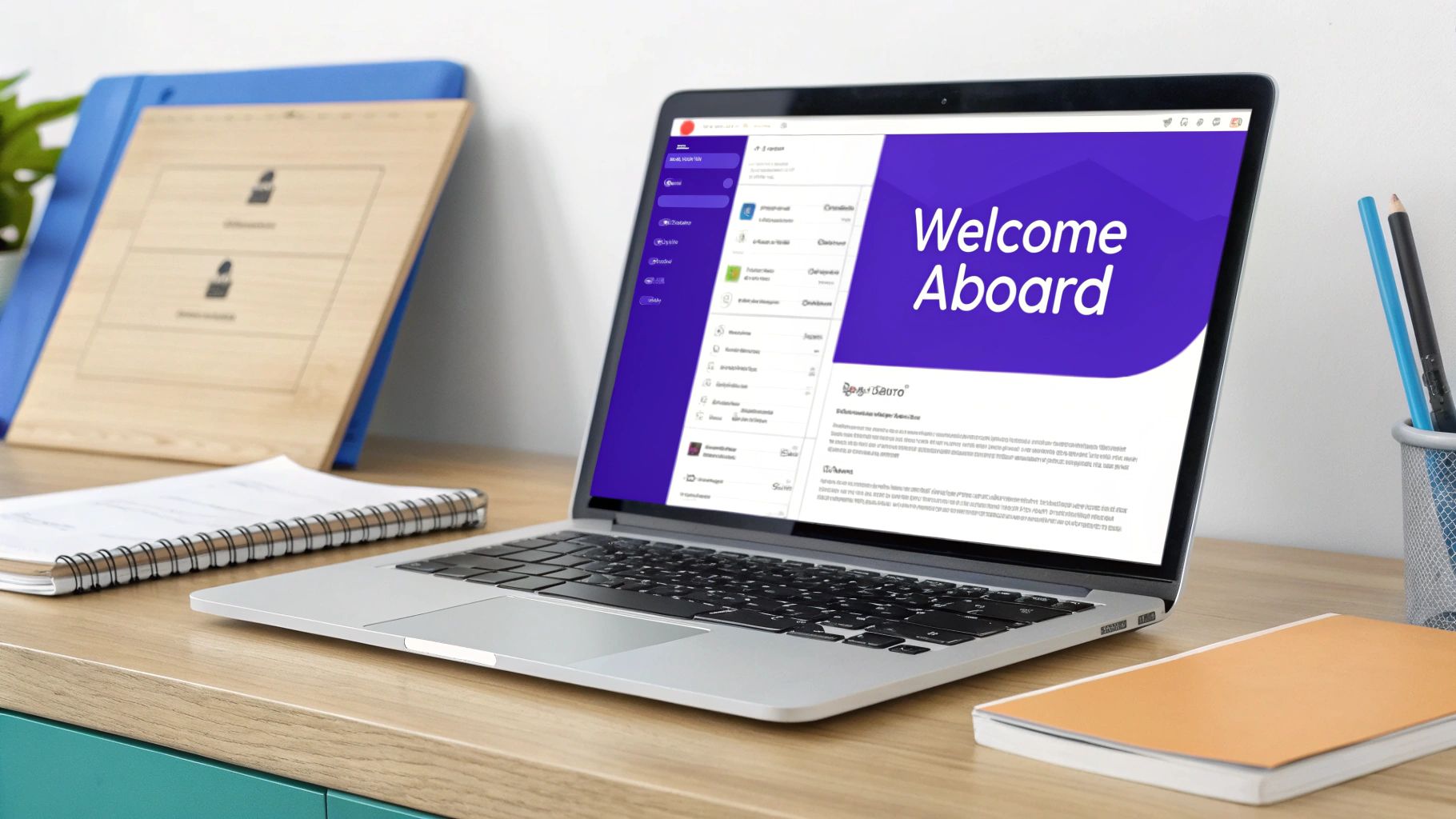
A well-crafted welcome email strategically incorporates key features to maximize its impact. These include a personalized greeting using the customer's name to foster a sense of connection, a concise introduction of your company and its mission, and a clear summary of what the customer can expect in terms of communication frequency and content. Crucially, it should include a clear call-to-action (CTA), prompting the customer to take the next step, whether it’s exploring your product, completing their profile, or browsing your online store. Finally, readily available contact information for support ensures the customer feels supported from the outset.
Examples of effective welcome emails include Slack's guided onboarding for new users, Airbnb's encouragement of immediate platform exploration, and Spotify's prompt for playlist creation. These examples demonstrate how a welcome email can drive initial engagement and showcase the core value proposition of the product or service.
Pros:
- Establishes an immediate connection: Personalized greetings and a welcoming tone make the customer feel valued.
- Positive first impression: A well-designed email conveys professionalism and sets expectations for a positive customer experience.
- Increased engagement and retention: Guiding users through initial steps encourages continued interaction with the product or service.
- Sets clear expectations: Outlines communication frequency and content, reducing potential confusion and frustration.
- Provides immediate value: Offering helpful resources, FAQs, or even a welcome discount can incentivize further engagement.
Cons:
- Inbox clutter: Welcome emails can get lost among other promotional emails.
- Standing out: Differentiation is key to capturing the customer's attention.
- Information overload: Too much information can overwhelm the customer and diminish the impact of the email.
Tips for crafting an effective welcome email:
- Conciseness: Focus on 1-2 key actions to avoid overwhelming the recipient.
- Conversational tone: Adopt a warm and welcoming tone to build rapport.
- Helpful links: Include links to resources, FAQs, and support documentation.
- Welcome offer: Consider offering a discount or special promotion to incentivize engagement.
- Subject line testing: Experiment with different subject lines to optimize open rates.
The welcome email's effectiveness has been popularized by industry leaders like Mailchimp, known for their onboarding email sequences; HubSpot, which advocates for customer service email best practices; and Buffer, recognized for their transparent customer communication approach.
This template earns its place on the list of essential customer service email templates because it lays the groundwork for a successful customer relationship. By leveraging personalization, clear communication, and strategic CTAs, the welcome email transforms a simple notification into a powerful engagement tool. This is vital for businesses of all sizes, from freelancers and entrepreneurs to large corporations, and across diverse fields like sales, marketing, customer support, and even event planning. By making a positive first impression and providing immediate value, the welcome email sets the stage for long-term customer loyalty and advocacy.
2. Order Confirmation Template
Order confirmation emails are crucial transactional messages sent immediately after a customer completes a purchase. Serving as both an official receipt and a reassurance of successful order processing, these emails provide essential purchase details and set expectations for the next steps. This makes them a critical component of effective customer service email templates, streamlining communication and fostering positive customer experiences. A well-crafted order confirmation email builds trust and reduces the need for customers to contact support, ultimately freeing up valuable resources.
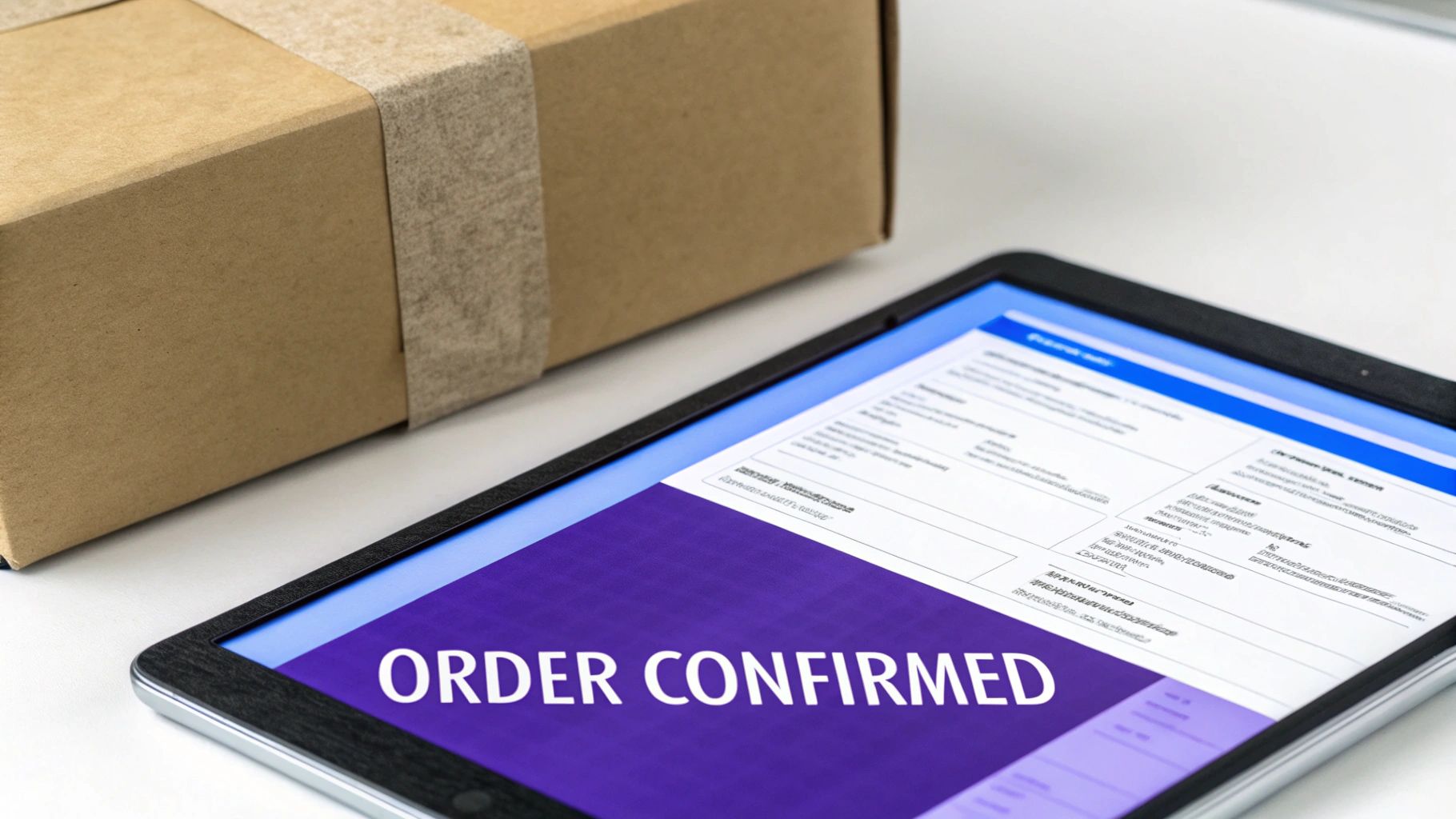
Key features of an effective order confirmation email include a clearly displayed order number, a detailed breakdown of the purchased products/services, a comprehensive pricing breakdown (inclusive of taxes and shipping costs), an estimated delivery or fulfillment date, payment information, and shipping address confirmation. These elements provide transparency and ensure the customer has all the necessary information at their fingertips.
Examples of Successful Implementation:
- Amazon: Provides highly detailed order confirmations with readily accessible tracking links, empowering customers to monitor their order progress.
- Apple: Employs a minimalist yet comprehensive purchase receipt, delivering essential information in a clean and concise format.
- Etsy: Personalizes order confirmations with seller information, fostering a more direct connection between the buyer and the independent vendor.
Actionable Tips for Creating Effective Order Confirmation Emails:
- Prominent Order Number: Ensure the order number is clearly visible and easily referenced.
- Clear Timeline: Outline the next steps in the order fulfillment process, setting clear expectations.
- Direct Tracking Links: Provide direct links to order tracking information, allowing customers to monitor their shipment's progress.
- Contact Information: Include contact information specifically for order-related inquiries, streamlining communication.
- Relevant Recommendations: Consider incorporating relevant product recommendations based on the customer's purchase history, opening opportunities for upselling or cross-selling.
- Mobile-Friendly Design: Optimize the email for mobile devices, recognizing that many customers check their orders on smartphones or tablets.
Pros and Cons of Order Confirmation Emails:
Pros:
- Builds Trust: Provides immediate confirmation and reassures customers that their order has been received.
- Reduces Support Inquiries: Minimizes the need for customers to contact support for order status updates.
- Upselling/Cross-selling Opportunities: Creates opportunities to suggest related products or services.
- Legal Record: Serves as a legal record of the transaction.
- Improved Customer Satisfaction: Enhances transparency and contributes to a positive customer experience.
Cons:
- Transactional Appearance: Can appear impersonal if poorly designed.
- Information Overload: Including too much detail can overwhelm the customer.
- Frequent Updates Required: If order status changes frequently, the template may require constant updates.
Why Order Confirmation Templates Deserve Their Place on the List:
Order confirmation emails are foundational to effective customer service communication. They contribute to a seamless post-purchase experience, reduce support burdens, and build customer trust. By leveraging best practices and thoughtfully designed templates, businesses can transform these transactional emails into valuable touchpoints that enhance customer satisfaction and loyalty. This makes them essential for Business Professionals, Sales and Marketing Teams, Customer Support Staff, Freelancers, Entrepreneurs, and even Event Organizers managing online registrations.
3. Problem Resolution Template
Problem resolution emails are a critical component of effective customer service. They serve as the primary tool for addressing customer complaints, resolving issues stemming from service failures, and ultimately, rebuilding damaged customer trust. These templates provide a structured framework for acknowledging mistakes, offering solutions, and turning a potentially negative experience into an opportunity to showcase a commitment to customer satisfaction. By utilizing a well-crafted problem resolution email template, businesses can streamline their responses, ensure consistency, and improve the overall customer experience. This approach is especially valuable for addressing common issues efficiently while still maintaining a personal touch.
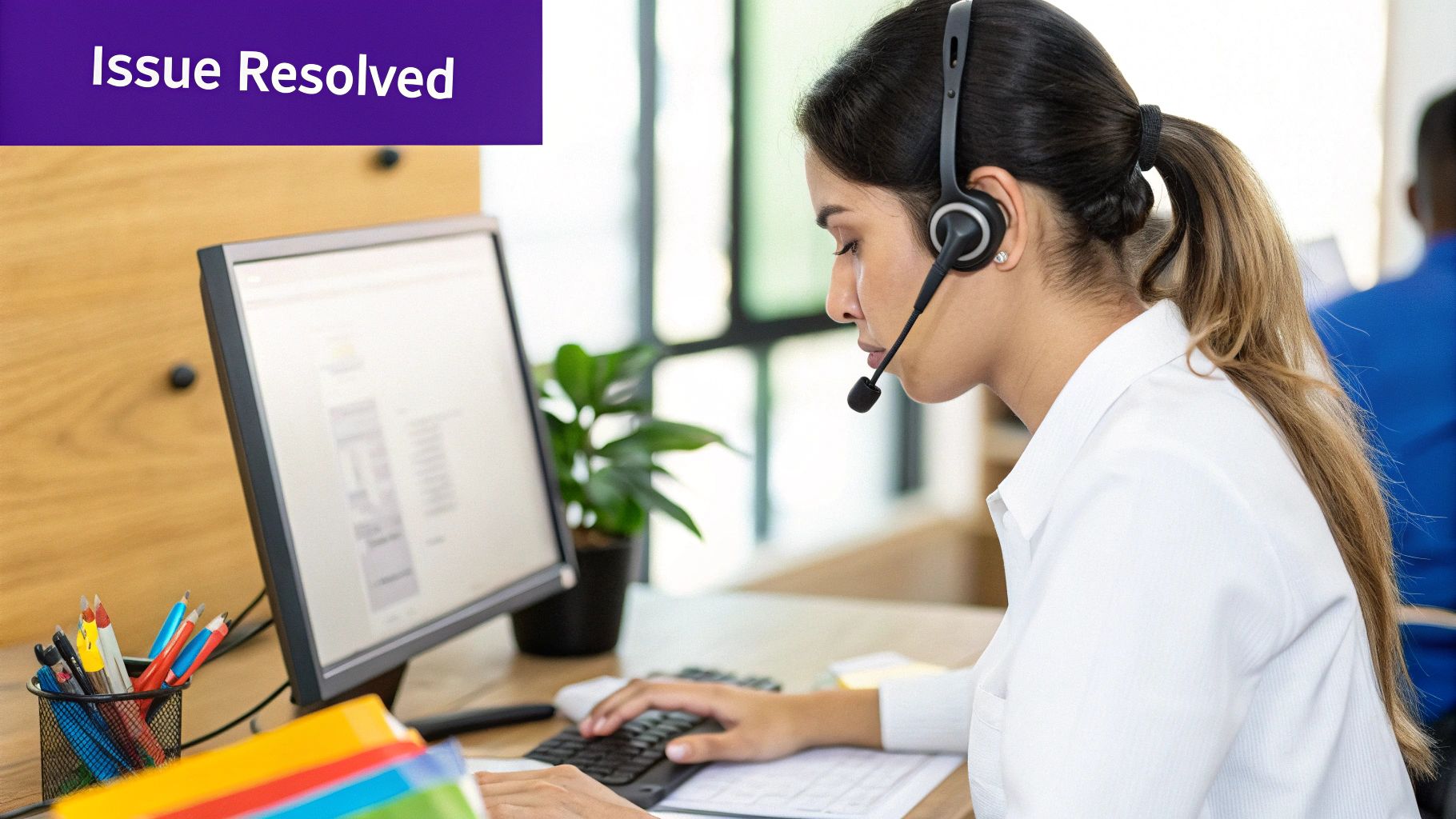
A well-designed problem resolution template incorporates key features that contribute to its effectiveness. These features include a sincere acknowledgment of the issue, a clear explanation of what went wrong (if known and appropriate), concrete steps being taken to resolve the problem, a compensation or goodwill gesture where appropriate, a follow-up timeline and expectations, and a personal sign-off from a specific team member. These elements work together to convey empathy, demonstrate accountability, and provide the customer with a clear path towards resolution.
Examples of successful problem resolution communication abound. Zappos is renowned for its legendary customer service recovery emails, often going above and beyond to rectify customer issues. Similarly, JetBlue has effectively utilized problem resolution emails to address flight delays, often including compensation details to mitigate customer frustration. Chewy, the online pet retailer, is another example, known for its personalized problem resolution communications that build strong customer relationships. These companies demonstrate the power of effective problem resolution in cultivating customer loyalty.
Pros: Implementing problem resolution email templates offers several advantages. They can transform detractors into loyal customers by showcasing a commitment to service recovery. They demonstrate accountability and reinforce company values. Further, they can proactively reduce potential negative reviews or social media complaints. Lastly, and importantly, they provide closure for frustrated customers. For businesses, the templates also create a documented record of issue resolution which aids in internal tracking and analysis.
Cons: Despite the benefits, there are potential drawbacks. Templates may require customization for complex issues, and overly templated or generic responses can seem insincere. Additionally, it can be challenging to address complex emotional concerns effectively through email alone, and the solutions offered may not always align with customer expectations.
Tips for Effective Implementation: To maximize the impact of problem resolution emails, respond quickly – ideally within hours of receiving a complaint. Avoid corporate jargon and use natural, empathetic language. Take ownership of the issue rather than deflecting blame, and explain what happened without making excuses. Clearly outline the steps being taken to fix the immediate problem and prevent recurrence. Finally, follow up after the resolution to ensure customer satisfaction. You can learn more about Problem Resolution Template.
Problem resolution templates deserve a place in every customer service toolkit. They provide a structured and efficient way to manage customer complaints, minimize negative fallout, and turn potentially damaging situations into opportunities for strengthening customer relationships. By focusing on empathy, accountability, and clear communication, businesses can leverage problem resolution emails to enhance their brand reputation and foster customer loyalty. This is especially relevant for business professionals, sales and marketing teams, customer support staff, freelancers, entrepreneurs, and even event organizers dealing with attendee issues. Investing in well-crafted problem resolution email templates is an investment in long-term customer satisfaction and business success.
4. Request for Feedback Template
A crucial element of effective customer service is understanding how customers perceive your offerings. The Request for Feedback template is a specific type of customer service email template designed to systematically gather these insights. It functions as a direct line of communication between your business and its customers, soliciting opinions, experiences, and suggestions on products, services, or even specific customer support interactions. By proactively requesting feedback, you demonstrate that you value customer input and are committed to continuous improvement based on real-world experiences. This helps establish a stronger customer relationship and fosters a sense of collaborative growth.
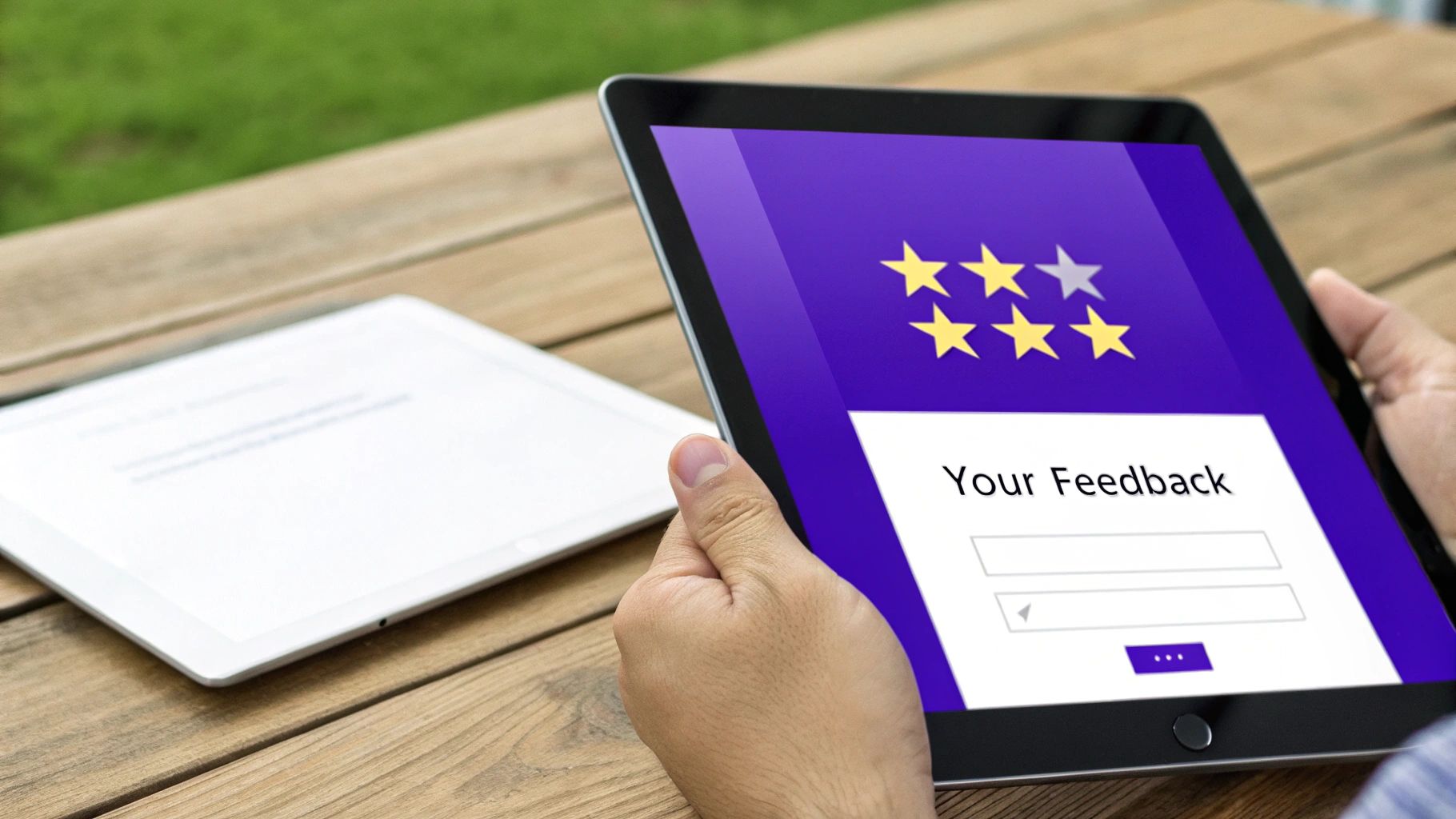
Well-designed feedback request emails incorporate several key features. First, they articulate a clear purpose statement, explaining why feedback matters and how it will be used. This transparency motivates customers to participate. They also provide a simple and accessible feedback mechanism, such as a survey link, a rating scale, or simply a reply option. Specifying the estimated time commitment for providing feedback encourages participation by managing expectations. Furthermore, personalizing the request based on specific customer interactions—such as a recent purchase or support ticket—adds relevance and demonstrates individual attention. Including an incentive for participation, when appropriate, can further boost response rates. Finally, assuring customers that their feedback will be reviewed and considered is vital for building trust and demonstrating the value placed on their input.
This template earns its place on this list due to its direct impact on improving customer satisfaction and business performance. The actionable insights gleaned from customer feedback can inform product development, refine service delivery, and identify potential pain points before they escalate into larger problems.
Pros:
- Provides actionable insights for product/service improvement
- Makes customers feel valued and heard
- Identifies potential issues before they escalate
- Helps measure customer satisfaction and loyalty metrics
- Can uncover unexpected opportunities for innovation
Cons:
- Survey fatigue if sent too frequently
- Risk of selection bias (only very satisfied or dissatisfied customers respond)
- May raise expectations that all suggestions will be implemented
- Low response rates without proper incentives or timing
Examples of Successful Implementation:
- Uber: Their post-ride rating email exemplifies a low-friction feedback mechanism, allowing users to quickly rate their experience with minimal effort.
- Airbnb: Post-stay feedback requests use specific questions tailored to the accommodation experience, gathering detailed insights.
- Amazon: Product review requests feature easy one-click rating options, simplifying the feedback process.
Tips for Effective Use:
- Send feedback requests at relevant moments (post-purchase, after support interaction).
- Keep surveys short and focused on specific aspects of the experience.
- Consider using Net Promoter Score (NPS) for simple, comparable metrics.
- Follow up on negative feedback with personal outreach.
- Share how previous feedback has led to improvements.
- Test different incentives to improve response rates.
Platforms like SurveyMonkey and Qualtrics, along with NPS-focused systems like Delighted, have popularized streamlined approaches to collecting and analyzing customer feedback. By leveraging these tools and implementing these tips, you can effectively use Request for Feedback templates to transform customer insights into a powerful driver for continuous improvement. Learn more about Request for Feedback Template This proactive approach demonstrates a commitment to customer-centricity and sets the stage for long-term business success.
5. Proactive Service Update Template
Proactive service update emails are a crucial component of effective customer service communication, earning their place on this list for their ability to foster trust and reduce support burden. These templates allow businesses to inform customers about planned changes, ongoing issues, or maintenance before they escalate into problems. This proactive approach demonstrates foresight, transparency, and a customer-centric mindset, ultimately minimizing disruption and enhancing the customer experience. This type of customer service email template should be a staple in any business' communication strategy.
How it Works:
A proactive service update email anticipates customer questions and concerns by addressing potential service interruptions or changes head-on. Instead of reacting to a flood of support tickets, businesses can control the narrative and manage expectations. This is achieved by providing clear and concise information about the situation, its potential impact, and any necessary steps customers should take.
Features of an Effective Proactive Service Update Template:
- Clear Subject Line: Immediately informs the recipient of the update's nature (e.g., "Planned Maintenance Notification," "Upcoming Feature Change").
- Explanation: Details the reason for the update, emphasizing its relevance to the customer.
- Timeline: Provides precise dates and times (including time zones) for any changes or disruptions.
- Impact Assessment: Outlines the expected impact on the customer's experience.
- Actionable Steps: If required, instructs customers on actions they need to take to minimize disruption.
- Alternative Solutions: Suggests alternative solutions or workarounds during service interruptions.
- Contact Information: Provides contact details for further inquiries.
Pros:
- Builds Trust: Demonstrates transparency and honesty, strengthening the customer-business relationship.
- Reduces Support Volume: Proactively addressing concerns minimizes the influx of support tickets.
- Customer-Centric Approach: Shows that the business prioritizes the customer experience.
- Preparation Time: Allows customers to adjust their plans and minimize potential inconvenience.
- Showcases Competence: Highlights organizational foresight and proactive problem-solving.
Cons:
- Potential for Concern: Poorly worded updates can create unnecessary anxiety or confusion.
- Highlighting Unnoticed Issues: May draw attention to problems customers were previously unaware of.
- Timing is Critical: Sending updates too early can lead to them being forgotten; too late, and they become reactive instead of proactive.
- Requires Updates: If plans change, the original update must be revised to reflect the latest information.
Examples of Successful Implementation:
- Google: Provides advance notice to developers about API changes, allowing them to adapt their applications.
- AWS: Issues service status updates before scheduled maintenance, minimizing disruption for users.
- Zoom: Notifies users about upcoming feature changes or potential outages, managing expectations.
Actionable Tips:
- Customer-First Approach: Focus on the impact on the customer, not technical jargon.
- Clear and Concise Language: Use plain language even when describing complex technical issues.
- Precise Timing: Include specific dates, times, and time zone references.
- Clear Expectations: Provide a clear timeline for resolution and details about future updates.
- Segmented Communication: Target only the affected customer segments to avoid unnecessary notifications.
- Calendar Integrations: Include calendar links for planned maintenance or downtime to facilitate scheduling.
When to Use Proactive Service Updates:
- Planned Maintenance: Inform customers about scheduled downtime and its potential impact.
- Service Disruptions: Communicate ongoing issues and estimated resolution times.
- Feature Changes: Prepare customers for upcoming changes to the product or service.
- Policy Updates: Notify customers about changes to terms of service, privacy policies, etc.
- Major Incidents: Provide regular updates during significant service disruptions.
Inspired by the success of platforms like StatusPage.io, Slack, and Microsoft in transparent incident communication and proactive updates, leveraging proactive service update templates allows businesses to improve customer satisfaction, build trust, and streamline support operations. By anticipating customer needs and addressing potential issues proactively, businesses can cultivate a more positive and resilient customer relationship.
6. Thank You Email Template
A crucial element in any comprehensive set of customer service email templates is the "Thank You" template. This type of email focuses on expressing genuine gratitude to customers for a variety of reasons, including purchases, loyalty, feedback, or specific actions they've taken. Effectively utilizing thank you emails strengthens emotional connections with customers by acknowledging their value beyond mere transactions. This fosters goodwill, encourages continued engagement with the brand, and ultimately contributes to higher customer lifetime value. This makes it an essential component for any business looking to improve customer relations and boost retention.
Thank you emails work by shifting the focus from a purely transactional interaction to a more personal one. Instead of simply confirming an order, a well-crafted thank you email acknowledges the customer's choice and expresses appreciation for their business. This can range from a simple "thank you for your order" to a more personalized message acknowledging their specific purchase and expressing excitement about them using the product or service.
Features of an Effective Thank You Email:
- Sincere expression of appreciation: Avoid generic phrasing. The message should feel genuine and heartfelt.
- Specific mention of what you're thanking them for: Did they make a purchase? Provide feedback? Refer a friend? Be explicit.
- Personalization: Use the customer's name and reference specific details to demonstrate genuine recognition.
- Optional small token of appreciation: A discount code, free resource, or early access offer can enhance the message but shouldn’t be the primary focus.
- Forward-looking statement about the relationship: Express anticipation for future interactions. For example, "We look forward to serving you again soon."
- Personal signature: A signature from a team member or leader adds a personal touch.
Pros:
- Strengthens emotional connection with customers
- Increases customer lifetime value and loyalty
- Creates positive brand associations
- Can encourage word-of-mouth recommendations
- Relatively low-cost way to improve customer satisfaction
- Can reactivate dormant customers
Cons:
- May seem insincere if sent too frequently or at inappropriate times
- Risk of appearing transactional if poorly executed
- Can be overlooked if not personalized enough
Examples of Successful Implementation:
- Chewy: Known for their handwritten thank you notes to new customers, creating a personalized and memorable experience.
- Warby Parker: Incorporates customer impact stories into their thank you messages, showcasing how customer purchases contribute to a greater good.
- Southwest Airlines: Sends anniversary thank you emails to loyal customers, recognizing their continued patronage.
Actionable Tips for Crafting Effective Thank You Emails:
- Send promptly: Deliver the thank you email shortly after the relevant customer action.
- Keep it concise: Focus on the customer and their action. Avoid lengthy or irrelevant information.
- Include specific details: Demonstrate that you know who they are and what they've done.
- Avoid hard sells: Don't immediately push for another purchase. Let the gratitude be the primary message.
- Consider unexpected timing: A thank you email doesn't always have to follow a purchase. Consider thanking customers for their loyalty or feedback at other times.
- Test personalized elements: Handwritten notes or highly personalized emails can have a greater impact.
Companies like Zappos, with their renowned customer appreciation approach, and Nordstrom, with their legendary thank you note culture, have popularized the importance of gratitude in customer service. Similarly, Starbucks utilizes thank you messaging within its rewards program to acknowledge customer loyalty. These examples demonstrate the long-term benefits of prioritizing customer appreciation.
Learn more about Thank You Email Template for specific templates and further guidance on crafting effective thank you emails. This type of customer service email template is indispensable for businesses of all sizes. By incorporating a sincere and well-executed thank you email strategy, businesses can cultivate stronger customer relationships, boost loyalty, and ultimately drive growth. This deserves its place on this list because it provides a high-impact, low-cost way to significantly enhance the customer experience and differentiate your brand from the competition.
7. Service Renewal/Upgrade Template
This customer service email template focuses on service renewal and upgrade opportunities, playing a crucial role in customer retention and revenue growth. These emails serve as timely reminders for upcoming subscription renewals or introduce customers to higher service tiers. Effective service renewal/upgrade emails provide transparent information about pricing, features, and options, ultimately empowering customers to make informed decisions about their continued service. This template deserves its place in the list because it directly addresses two key business objectives: reducing churn and increasing customer lifetime value.
How it Works:
Service renewal/upgrade emails operate on a simple premise: proactively communicate with customers before their current subscription expires. This communication can take several forms: a straightforward renewal reminder, an offer to upgrade to a premium tier, or a combination of both. The core components are clear communication about the upcoming renewal date, transparent pricing details, and a summary of the current services and their benefits. Effective templates also highlight any new features or improvements introduced since the initial purchase, showcasing the ongoing value proposition.
Features and Benefits:
- Clear Timeline for Renewal: Provides specific dates for upcoming renewals, avoiding any surprises for the customer.
- Transparent Pricing Information: Clearly outlines the cost of renewal and any price differences for upgrades.
- Current Service Summary: Reminds the customer of the benefits they are currently receiving.
- New Feature Highlights: Showcases improvements and additions to the service, reinforcing its value.
- Upgrade Options & Comparative Value: Presents available upgrade options and clearly articulates the additional benefits they offer compared to the current plan.
- Simplified Renewal/Upgrade Process: Provides clear instructions and easy-to-use links for renewing or upgrading.
- Consequences of Non-Renewal: Explains the implications of not renewing, such as data retention policies or service termination.
Pros:
- Churn Reduction: Proactive communication reduces involuntary churn due to expired payment methods or forgotten renewals.
- Revenue Growth: Presents opportunities to upsell customers to higher-tier services.
- Transparency and Trust: Open communication about pricing and service details builds customer trust.
- Service Review & Improvement: Provides a natural opportunity for customers to review their service usage and consider improvements.
- Reactivation of Interest: Can re-engage customers with underutilized features.
Cons:
- Potential Cancellations: If the value proposition isn't clearly communicated, these emails can trigger cancellations.
- Aggressive Upselling: Overly aggressive upgrade messaging can alienate customers.
- Timing is Critical: Sufficient time must be allowed for customer decision-making.
- Personalization Needed: For optimal results, messaging should be tailored based on individual customer usage patterns.
Examples of Successful Implementation:
- Spotify: Regularly emails users about Premium tier upgrades, highlighting ad-free listening, offline playback, and enhanced audio quality.
- Adobe Creative Cloud: Sends renewal notices that include personalized usage statistics, showcasing the value derived from the software.
- The New York Times: Renewal emails often highlight the subscriber's most-read sections, reinforcing the relevance of the subscription.
Actionable Tips:
- Start Early: Begin the renewal sequence 30-60 days before the subscription expires.
- Segmentation: Tailor messaging based on customer usage patterns and subscription tiers.
- Value Highlighting: Quantify the value received through usage statistics, ROI indicators, or other relevant metrics.
- Testimonials: Include testimonials from satisfied customers at higher service tiers.
- Loyalty Incentives: Offer discounts or bonus features for multi-year renewals.
- Account Management Access: Provide easy access to account managers for questions and personalized assistance.
- A/B Testing: Test different value propositions and messaging strategies for various customer segments.
Popularized By:
The effectiveness of tiered service models and proactive communication for renewals and upgrades has been demonstrated by companies like Salesforce, Netflix, and Microsoft 365, all of which have robust systems for managing subscriptions and encouraging upgrades.
When and Why to Use This Approach:
This template is essential for any business operating on a subscription model. It's a proactive approach to customer retention and revenue generation. Use this template when:
- Subscriptions are nearing expiration: Trigger emails based on the subscription renewal date.
- New features or service tiers are launched: Inform existing customers of new opportunities to enhance their experience.
- Customer usage patterns suggest potential for upgrade: Target customers who could benefit from higher-tier features.
By leveraging the service renewal/upgrade email template strategically, businesses can effectively manage their subscriber base, minimize churn, and maximize customer lifetime value.
7 Email Templates Comparison
| Template | Implementation Complexity 🔄 | Resource Requirements ⚡ | Expected Outcomes 📊 | Ideal Use Cases 💡 | Key Advantages ⭐ |
|---|---|---|---|---|---|
| Welcome Email Template | Low | Low | High engagement, customer retention | New customer onboarding | Establishes connection; sets tone |
| Order Confirmation Template | Medium | Medium | Immediate trust, reduced support queries | Post-purchase transaction confirmation | Builds trust; legal record |
| Problem Resolution Template | High | High | Customer recovery; reduced negative feedback | Handling complaints & service issues | Demonstrates accountability; rebuilds trust |
| Request for Feedback Template | Medium | Medium | Actionable insights; improved satisfaction | Gathering customer opinions | Gains valuable feedback; boosts loyalty |
| Proactive Service Update Template | Medium | Medium | Reduced support volume; increased transparency | Notifying about changes/issues | Builds trust; prepares customers |
| Thank You Email Template | Low | Low | Strengthened customer relationships | Expressing gratitude after key actions | Increases loyalty; positive brand image |
| Service Renewal/Upgrade Template | Medium | Medium | Higher retention; upsell opportunities | Subscription renewals and upgrades | Reduces churn; drives revenue growth |
Level Up Your Customer Communication
This article has explored seven essential customer service email templates – from welcome emails and order confirmations to problem resolution and feedback requests – providing you with the foundation for effective customer interactions. By implementing these customer service email templates, you can streamline your communication processes and ensure consistency in your messaging. We've covered templates for proactive service updates, thank you notes, and even service renewals/upgrades, offering a comprehensive approach to managing the customer lifecycle through email.
The key takeaway here is that utilizing well-crafted customer service email templates empowers you to create positive experiences at every touchpoint. Whether it's resolving a customer issue efficiently with a dedicated problem resolution template or fostering loyalty with a personalized thank you email, these templates provide the tools for success. Leveraging these templates, along with AI assistance from resources like quiky.email, allows you to optimize your time and resources, freeing you to focus on more strategic initiatives.
As a next step, analyze your current customer service email strategy and identify areas where these templates can be integrated. Don't be afraid to adapt and customize them to reflect your brand voice and specific customer needs. Regularly reviewing and updating your customer service email templates based on performance data and customer feedback is crucial for staying ahead of the curve.
Mastering these concepts is directly tied to building stronger customer relationships, enhancing brand reputation, and ultimately, driving business growth. In today's competitive landscape, exceptional customer service is a key differentiator, and these templates are a vital component in achieving that.
By investing in improving your customer communication through effective customer service email templates, you are investing in the future of your business. Start optimizing your emails today and watch your customer relationships flourish.
Key Takeaways
Essential learnings that you should remember from this article
- Understand the importance of personalized communication in customer service.
- Learn how to effectively use email templates to streamline customer interactions.
- Recognize the key features of each email template and their impact on customer satisfaction.
Practical Tips
Actionable tips you can apply immediately to improve your email performance
Use Personalization
Incorporate the customer's name and specific details to make emails feel more personal and engaging.
Optimize for Mobile
Ensure all email templates are mobile-friendly, as many customers will access them on their smartphones.
Test and Iterate
Regularly review the performance of your email templates and adjust based on customer feedback and engagement metrics.
Common Mistakes to Avoid
Pitfalls and misconceptions to avoid when writing persuasive emails
- Overloading emails with too much information can overwhelm customers.
- Failing to personalize emails can make them feel generic and less engaging.
- Not following up on feedback or complaints can damage customer trust.
Tools to Apply These Concepts
Put what you've learned into practice with these specialized tools
Related Content
Continue exploring with these related articles and tools